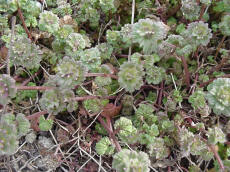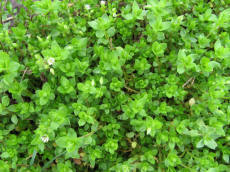|

Henbit (click on picture for larger image)
Henbit is the No. 1 weed of the week, and chickweed is a very
close second. Chickweed and henbit are weeds that get going very
early in the spring. We even call them winter annuals. Right now
chickweed stands out in yards, since it is quite abundant and
has a lighter green color than grass and most other weeds. I
can't begin to tell you how to identify it; it gets even harder
when there is a common chickweed and mouse-ear chickweed. Henbit
is easier to identify since it has purple flowers and smells
like mint. As for control, that gets a bit easier.

Chickweed (click on picture for larger image)
The
straight 2,4-D that is used on dandelions seems to act like a
fertilizer for chickweed and other problem weeds. Combinations
that contain 2,4-D, MCPP and dicamba are rated very effective on
chickweed, henbit, red sorrel, purslane, white clover and
others. These combinations are sold under several different
trade names. You can find these at most hardware, discount, and
lawn and garden stores. Just check the label under active
ingredients and check for two long chemical names and dicamba.
You can also check to see that it says it will control chickweed
and henbit. This group of chemicals is effective in the
50-degree range and up.

As with any chemical control, read and follow label
instructions very carefully. On these product labels there will
be some cautions that you should be aware of concerning injury
to sensitive plants. This is because dicamba can drift as a
vapor for a few weeks after you apply it if the weather gets hot
and sunny. If you put down new grass seed, don't use the
chemical control at this time. The rule of thumb is to mow new
grass three times before you apply anything (rough translation
of three months after seeding).
[to top of second column]
 |
 Current topics
Here are some of the current items of note:
Remember to finish up new seedings this week. Of course, you
may have luck with later seedings, depending on temperature and
moisture conditions. Frequently, later seedings start well and
gradually disappear in the heat of the summer. Remember: no
herbicide treatments of any type during the spring growing
season.
Crabgrass control:
It's about time for the preventive applications to control
crabgrass and other annual weeds. Soil temperatures above 55 for
about a week are the trigger for germination. Another indicator
is forsythia in bloom.
Nuisance pests:
With some warm days, we have seen the return of nuisance
pests. Boxelder bugs, Asian lady beetles, millipedes and more
have started moving. These are nuisance pests because they
really don't do any harm. The best control in a house is to suck
them up with a vacuum. Foundation sprays of permethrin or
bifenthrin can help reduce the number getting into the house,
but they won't eliminate them.

-
Start tender
transplants: Remember to start tender plants about six weeks
ahead of wanting to set them out. This would include your annual
flowers, tomatoes and peppers. Wait a week or two on the melons,
squash and eggplant. Many growers start seeds to get a jump on
the season for these warm-loving plants.
-
Put the Master
Gardener plant sale on your calendar for April 28 if you are
interested in picking up some quality plants at a reasonable
price. More information will be coming out on the plant sale.
[Text from file received from
John
Fulton, University of Illinois Extension,
Logan County Unit]
 |